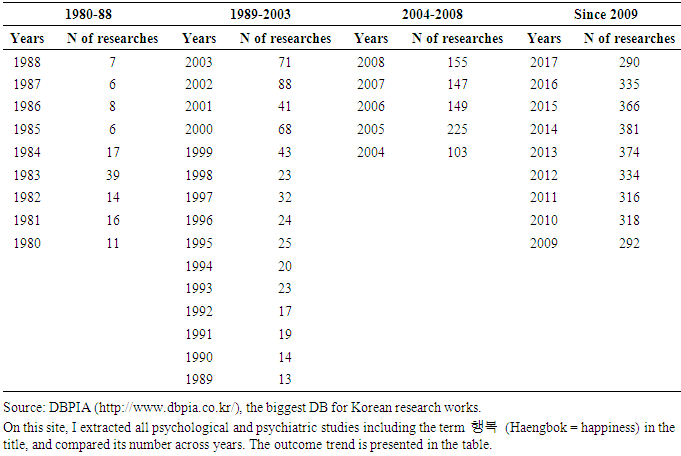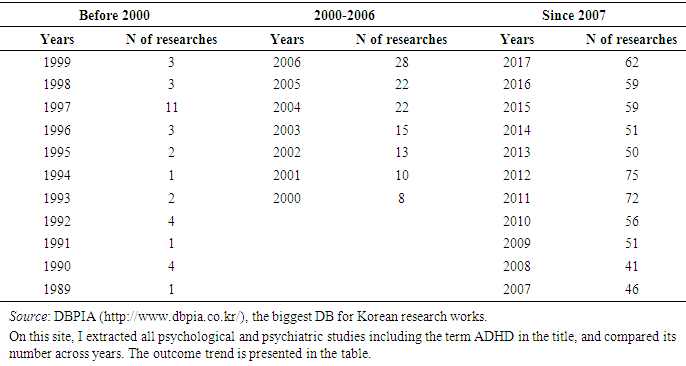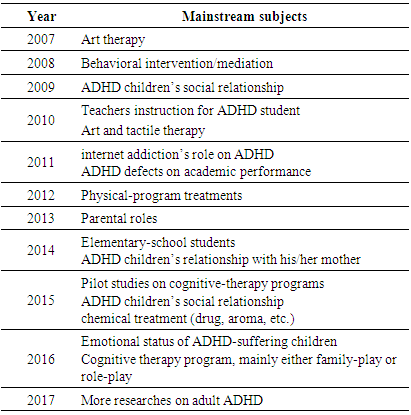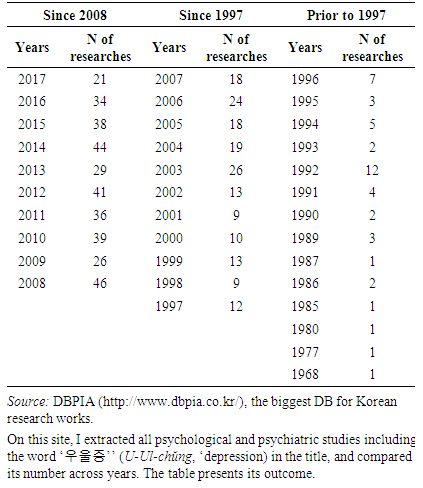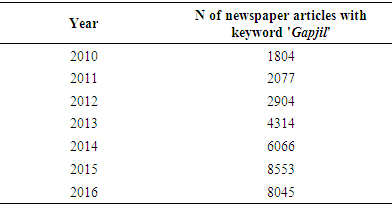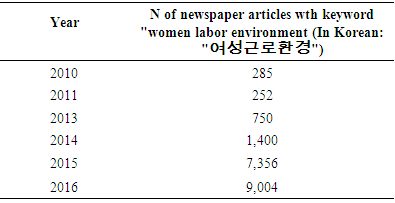-
Paper Information
- Paper Submission
-
Journal Information
- About This Journal
- Editorial Board
- Current Issue
- Archive
- Author Guidelines
- Contact Us
American Journal of Sociological Research
p-ISSN: 2166-5443 e-ISSN: 2166-5451
2018; 8(1): 1-13
doi:10.5923/j.sociology.20180801.01

When Individual Mind Becomes the Social: Social Structure, Value Change, and New Emergence of Korean Psychology
Ki-Hoon Jun
Latin American Studies, Graduate School of International Area Studies, Hankuk University of Foreign Studies, Seoul, South Korea
Correspondence to: Ki-Hoon Jun, Latin American Studies, Graduate School of International Area Studies, Hankuk University of Foreign Studies, Seoul, South Korea.
| Email: |  |
Copyright © 2018 The Author(s). Published by Scientific & Academic Publishing.
This work is licensed under the Creative Commons Attribution International License (CC BY).
http://creativecommons.org/licenses/by/4.0/

Theoretically, the linkage between social change, value priority, and ontological matters has been established. However, the attempts to apply it to the real-world history have been relatively few, especially when the subject of value-priority is the mind. In the present article, I apply those dyanmics for the history of South Korea, with twofold elaborations. In the first part, I employ discourse-analysis with historical texts about Korean society, social-relationship value, cohesion/competitiveness. Doing so, I explain how Korea’s social change led to fragmented individualization by 2000s, which in turn changed social-priority from perseverance to emotion-acceptance. In the second part, I associate those changes with emergence of Korean psychology/psychiatry at around 2008-2010, along with argument that even those studies’ approaches are strongly influenced from yearly-trend of social issues. In sum, with the example of South Korea, I demonstrate how the theoretical linkage between social-change, mind-priority, and researchers’ focus ontology can be observed in the real world. After all, although psychologists explore individual mind seeking neutrality in method, certainly their subject-selection and social influence are social products.
Keywords: Minds and society, Psychology as social reflection, Perseverance for achievement, Social mobility and emotion
Cite this paper: Ki-Hoon Jun, When Individual Mind Becomes the Social: Social Structure, Value Change, and New Emergence of Korean Psychology, American Journal of Sociological Research, Vol. 8 No. 1, 2018, pp. 1-13. doi: 10.5923/j.sociology.20180801.01.
Article Outline
1. Introduction
- South Korea, the country I address in this article, may not have been so central subject to many cultural-psychologists, sociologists, or ontologists. However, I assert its study3 is very worth for its uniqueness, represented by economic miracle from 1960s to 1990s and its cease by the end of 2000s. In this paper, with such unique features of this country, I illustrate how a society’s change can affect the values on human minds, and in turn, also the nature of academy about human minds – i.e.> psychology and psychiatry.Such linkage between social change, culture of minds, and studies about minds, first starts from Matsumoto’s two theoretical basics [1]: first, he argues that culture is subsequent reflection of social environment and its changes; second, minds are also often crutical parts of those cultural reflections. His foundational theory, by its logics, leads to the following conjecture — when society alters, culture alters, and so are people minds likely to be. On the other hand, ontologically, the academic sight could be also affected from such interaction between social-change phases and values. As Weber argued [2], the rule of neutrality applies only to methods and approaches, not fully to the choice of research focus and subjects; the latter is, at least partially, left to personal judgment, which is in turn largely affected by social trend surrounding him/her. With all those theoretical grounds, the present article explores 1two distinct but mutually-unseparable mechanisms. First one is, Korean society almost-reversing transition — it had been oriented to authority-led growth (especially for economic thriving and living-quality) until 1980s, but then began turning to just a part of world economy which is now vulnerable to any shock from anywhere. I want to argue, with evidences provided by meta-analyses, those transitions also brought Koreans minds’ displacement from long-standing collectivism to fragmented-individualism.As well, I will also add that those drastic changes of Koreans’ minds came out at around 2008, when people got to recognize that their previous values no longer work to better-off their life. After suggesting those two’s concurrence, then I turn to timely changes occurring also in the nature of Korean psychology and psychiatry, which were sparked from 2008. By showing that those academic trends are reflection of ongoing social changes, I will eventually complete the mechanisms flowing from mega-social trend to values in emotions, and to its academic reflections.
2. Literature Review about Koreans’ Mind in Transformation: From Collectivism to Fragmented Individualism, and from Persverance to Emotion
2.1. Brief Summary on Collectivism to Fragmented Individualism, and Perseverance to Emotion
- In this section, I want to say about the big picture of the social change of South Korea since late 20th century until the present. At the same time, I will also discuss value-transitions of Koreans since the global economic crisis 2008, from collectivism to fragmented individualism, and from perseverance and achievement to emotion-orientedness, which caused the new wave of psychological/psychiatrical studies since 2008-2010.Hofstede points out that the nature of perseverance is emotion-control [3]. That is, perseverance and emotion-acceptance, to a certain degree, are mutually opposite thing. And in this section, I want to point out that for a long time Koreans were more inclined to perseverance over emotion, due to strong belief on the value of effort and on the achievement. This is only changed since around between 2008 and 2010, when global economic crisis in 2008 ceased Korea’s economy miracle, and augmenting vis-a-vis competitiveness made people live life more alone. Historically in Korea, and effort assured success, perseverance was prioritized over emotion-expression because of two factors. One is long-time persistence of collectivism until mid-2000s which was firmly rooted from authoritarian-regime era, as I will explain below. The other cause of perseverance-over-emotion was long-standing social belief that constant effort will compensate. Since 1990s there were more stressing-out elements with augmenting competition, as will be stated below, people stood with it for a long time, due to belief that in the long run it will award them and their socio-economic status will be different. It was like “I feel hard, but I will not say so: I will go on with hard-working, for final awards”. So negative emotion could be oppressed. However, when the economic-miracle was put to the end following and people recognized that constant effort no longer guarantees anything, then they began to look at their minds; perseverance no longer could be over emotion/minds. This drastic change intensified as the society became even more competitive and the fragmented individualism began to replace traditional collectivism — when everyone living alone, each sees more of one’s minds. This made the emotion important for the first time for Koreans, and it is this time when there was new wave of psychological and psychiatric studies in Korea.
2.2. Factors of Collectivism until Mid-1990s
- Until the end of authoritarian regime at late 1980s, the collectivism of Koreans appeared either in the form of cooperation with the development state, or in the form of resistance against dictatorship [4]. And due to strong importance of social relationship, and enterprise culture emphasizing loyalties and cohesion, the collectivism persisted even after political democratization [5].Furthermore, the enterprise culture of South Korea added to the collectivism; until mid-1990; layoff was very rare, and one recruited the lifetime hiring was secured unless (s)he was too bad employee; so that competition within company was not so harsh and the organization could be cohesive [6].
2.3. The Age of Increasing Competitiveness, Since 1990s
- However, along with ongoing economic growth since 1990s, Koreans began to suffer more stress and uncertainties, due to two elements intensifying competitiveness.First, the Asian financial crisis in 1997 made large companies abolish previous lifetime-hiring system, and layoff expanded. Therefore, the competition in companies was to intensify. Secondly, while until 1970s the Koreans’ education competition was based on voluntary sense of responsibility to rebuild his family through success, its nature changed since late 1980s: now, studying was something imposed by Tiger-mom.Another source of competition was end of lifetime-hiring custom, following Asian financial crisis of 1997. Around this time, several conglomerates of Korea went bankrupt. And Korean government had to get loan from IMF, who imposed labor-flexibilization policy. So layoff system began introduced. Furthermore, the survived conglomerates’ owners felt they had to change management, seeking more profitability. Now labor-cost reduction became relevant. Then, sudden flow of massive layoff/firing was followed by economic crisis 1997. And of course, the within-workplace competition not to lose his/her job became intensive.Yet, since 1990s, Koreans society began to suffer more stress from intensifying competitiveness, which is a contrary value to collectivism. This has appeared in two realms: education, and company workplace.
2.3.1. Changing of Academic Competition’s Meaning
- During 1980s, the dictator-government by Chun Doo-Hwan put two major-changes in the educaiton system. First, the government attempted to intensify the competition for university entrance, by over-spreading social-image about ‘romantic’ university life by the media. Secondly, under new education-system, now high-school students were ‘confined’ in school until night in the name of extracurricular studies, making them no longer aware of social malaises under suffocating dictatorship. Those two changes made academic-competition much more fierce and less voluntary than before; students were now forced to keep studying in the school beyond their choice. And those problems lasted even after the dictatorship was collapsed by 1989 and replaced by democratic regime. Furthermore, since Korea is no longer poor country, and parents had means to financially support and control children’s academic endeavors. That is, the “Tiger-Mom” family emerged. Until 1970s, not going to university was not a shame, but since late-1980s it became the must. And while previous generation studied with sense of voluntary responsibility to rebuild his/her poor family, now for children study became something pressured by his/her Tiger-Mom. So, Korean children have become extremely unhappy already from early 1990s. It was 1994 when a kid’s suicide for academic failure was reported for the first time ever. And then, every year more than 10 have killed themselves, and since 2010 annually over 20. But not all facets of a culture change concurrently and coherently. That is, Korea’s Tiger-Mom culture at that time is quite similar to recent U.S. trend, but unlike U.S. Korean parents’ authority could never be questioned. So, physical punishment for academic performance has been never a shocking event in Korea, and there was nothing to discourage parents from putting excessive pressure on their children. Therefore, students’ suicides until mid-2000s were never attributed to excessive pressures from their parents. It was always the education-system as abstract and vague thing to be blamed for such tragedy. It is only in 2008 that social voice calling for parents tolerance was raised (Health Chosun, 2009), too lately. Under such culture, students have had to compete on their own, in all-against-all.
2.3.2. Augmenting Competition at Workplace: Since Asian Financial Crisis 1997
- Shortly after political democrazation, it is Chaebol —Korea’s largest business-groups in similar structure to that of Zaibatsu—, who took hegemony of society instead of previous dictators. In fact, political democratization did not lead to equality in all spheres. Despite such social power, until mid-1990s, Korean companies did not like massive layoff merely for cost minimization. Their culture had been collectivism, and getting employees’ voluntary loyalty and sense of belonging was very important for most large-business owners. So while they demanded employees to attend regular informal dining where everyone drinks and talks together, they promised lifetime-hiring to most of employees. Layoff and firing were rare. Even when they wanted a bad employee out, they never directly fired him/her; instead, they just let him/her stay idle at office without giving any work, while still paying wage. Months later, the bad employee will see he/ she is not wanted person in the company, and he/she will leave Voluntarily. “Once you’re accepted as our company’s member, you are forever one of us. Even when we don’t want you, it is you to decide to leave”. And feeling their place secured, employees were voluntarily loyal.However, Korean enterprises’ custom of lifetime-hiring and loose collectivism was broken after Asian financial crisis 1997. Around this time, several conglomerates of Korea went bankrupt. And Korean government had to get loan from IMF, who imposed labor-flexibilization policy. So, layoff system began introduced. Furthermore, the survived conglomerates’ owners felt they had to change management, seeking more profitability. Now laborcost reduction became relevant. Then, sudden flow of massive layoff/firing was followed by economic crisis 1997. And of course, the within-workplace competition not to lose his/her job became intensive.
2.4. Until 2008: Standing with Competitiveness
- I have said the competitiveness and its stress were augmented in Korea since 1990s, for two factors: emergence of Tiger-Mom culture pressuring on academic performance, and disappearance of lifetime job security.Nevertheless, this did not immediately made people believe that the life is alone competing against all the others vis-à-vis. Still the authority and importance of parents was utmost emphasized. Furthermore, Korea escaped rapidly from economic debt on IMF, and was considered as successful model overcoming financial crisis. Those leaved rooms for belief on success and social mobility through efforts and perseverance. Still Koreans strived, and so-called emotion was a thing to be left behind. It is this period that tradition of job security through lifetime-hiring began to disappear. The neo-liberalistic IMF authority urged labor market’s flexibilization, and large companies (Chaebol) began to introduce layoff system to reduce cost, as they began to lose in the market. Previously, firing was very rare in Korean companies, for two reasons. First, collectivism was important value in Korean enterprises. Therefore, they preferred to keep the same employees for a long time so that everyone gets familiar with each other and stays loyal to the company (Even nowadays, the main catchphrase in Korean large business-group is “Company like a family’, though they no longer guarantee much to employees). While they were gaining enough profits until 1997, they had few reason for frequent layoffs. It changed after the crisis in 1997.While the 1997 crisis made company-life more competitive, because lifetime job is no longer secured, this did not immediately lead to individualization. Still people stayed with collective minds. While they could not be loyal to their hiring company as before, they still relied on and prioritized social relationship hierarchy with their senior/Seonbae, parents, relatives, etc. And Korea’s social mobility was still considered high, by which people held belief they could success through efforts. By this, people stood with unfair behaviors by boss, long-hours working condition, and many other stressful factors at workplace and social relationship.
2.5. After 2008: Transition to Fragmented Individualism, and Emotion over Preseverance/Efforts
- However, a decade later, Korea economy faced the second crisis — impact of global economy crisis 2008. It is this time since which Korean economy lost dynamicsi. And as aforementioned, it had been long ago that large enterprises Chaebol took dominant hegemony over Korean government. Following chronic stagnation and domestic-market reduction, now they began to significantly reduce job-offering to minimize cost. They were still gaining profit, but they could not accept even small decrease of it. That explains their active attempt for labor-cost minimization, this suddenly increased uncertainty of life and future, for 20s and 30s. Job insecurity once aggravated after 1997 crisis, but this time the aggravation-level was far more drastic. It is since this year, 2008, that Korean social mobility began to weaken, and people began to doubt on the value of consistent efforts [7]. At the same time, the competition among fragmented individuals began to surge among early 20s — university students.
2.5.1. Cease of Social Mobility, and Fragmented Individualization
- The global economic crisis in 2008, on the other hand, put to the end of Koreans’ firm belief on the value of perseverance over emotion, and of traditional collectivism. Since then, Korea’s economic miracle was put to the end; the previous growth rate always over 5%, since 2010, fell down to between 2-3% [8] — this was a big difference.The cease of economic thriving also reduced the room for social mobility. Unlike in the past, the prestigious-university entrance no longer guarantees success, because job places themselves were narrowing down. Soon it became like that people had to struggle and compete vis-à-vis lifetime, just to survive.With this endlessly intensifying competitiveness, people began take alone-life. Fragmented individualism began replacing traditional collectivism. The first change occurred among university students. There were no longer seniors (Seonbae in Korean) for freshmen to get along with; the seniors themselves had to struggle to get a job and survive. Average GPA of most universities soared, and more and more students began choosing to live on his (her) own for future [9]. And living alone became popular soon, also among 30s.
2.5.2. Broken Belief in the Value of Perserverance— Now Mind Begins to Matter
- Meanwhile, although society demanded constant competition for survival, people began to recognize that they cannot live in that way, forver. They began to recognize that constant effort and perseverance no longer changes their life. The value of perseverance is over — anyone cannot live his/her whole life just to compete, struggle, and put up with everything. It is then when Koreans began falling into their inside for the first time. That is, by then the emotion and mind began to matter more for Koreans. Unconditional perseverance, putting up with all the stress and problems no longer changes anything. At the same time, living alone more, they fell more into their own inside/minds. So, since 2008-2010, for the first time, Koreans began to pay attention to their own minds and emotions. And as argued below, that change is reflected in the history of Korean psychology/psychiatry involving happiness and some other mental syndromes.
3. Meta-Analysis: Trends in Korean Psychology/Psychiatry Research, as the Social Change’s Consequences
- All title and author details must be in single-column format and must be centered.With the Korean social value’s priority transition from perseverance to the emotion-acceptance, also there has been the late but radical changes in the trend of psychological/ psychiatry research. For example, as shown below, it is since 2010 that younger generation than the elderly became the focused group of happiness. In this chapter, I will contemplate on the since-2008 change of Korean psychology/psychiatry about happiness, ADHD, and depression, in relation with vairous social contexts.
3.1. Annual Social Contexts of Happiness Researches in South Korea
- The first-ever research about happiness in Korea was no earlier than 1987, over 5-decades later than the first establishment of psychology department in Korea [10]. There are two reasons’ for such lateness. First, similar to Japan [11], traditionally the happiness was not the value priority; with heavy influence of ancient China’s Confucianism, rather attitudes like self-control, wisdom, harmony, and equilibrium were core value in pre-modern age of Korea. Secondly, as in other developing countries, the concern on happiness was too much until Korea escaped poverty; having suffered devastating-war for three years, and then dictatorship for decades, some young people prioritized collective solidarity to struggle with authoritarian regime; and the others prioritized raising their families’ social status through educational endeavors.The happiness researches in Korea began in 1991 [12], but for following decade it was only about retired elderly-men’s subjective well-being. Despite Korean’s happiness level has lower than economic level almost consistently, there have been fewer attention to pursuit of happiness until 2008. It was only since 2007 that the young generation — in this year mainly university students — which was subject of focus of happiness for the first time.In fact, Table 1 clearly shows that the happiness studies in Korea fully reflect the social value changes. During the first-period of 1980-1988, when collective rage against dictatorship was predominant emotion, the individual happiness was not of priority; so during this time the happiness researches did not increase at all. It was since 1999 following Asian financial crisis that happiness studies in Korea began substantial increase. After that, followed by slow-down of further increase during 2004-2008, then happiness studies in Korea began to enter into the boom (e.g. since 2009, the number of studies has doubled). Now, individual happiness has become far more important than in the past, and Table 1 confirms that it is also reflected in research history.• 2017: Subjective belief on happiness [13-16]• 2016: The importance of appreciating attitude and optimism [17-20]• 2015: The significance of consumption pattern for happiness, and across-generation variance of happiness seeking and its valuation [21-24]• 2014: The importance of other attitude but gratitude, for happiness [25-27] • 2013: effect of personal traits and subjective belief [28-32]• 2012: significance of purposeful life, especially for the elderly; beliefs involving happiness and its consequence on the real happiness [33-35]• 2011: Developing Korea-version scale, and cultural trait of Koreans’ happiness [36-40]• 2010: mainly about adolscents’ happiness, and inter-generational variance [41-46]• 2009: Mainly about Happiness in the youth, within parent-child relationship, and happiness’ association with other psychological dimensions [36, 47-49])• 2008: mainly involving happiness effect on future/career success [50, 51]• 2007: happiness for University students, and happiness’s association with internal value [52-54]• 2006: As well as socio-psychological traits, also the psychological attraction’s relationship with happiness have been mainly addressed. And the same for 2006 [55]• 2003-2004: Trend of happiness for Koreans [56, 57]With the change of mainstream subjects over time, the following trend is shown. Until the early 2000s, before the Korean culture changed into fragmented individualism, the happiness studies focused on the Korean as the whole and in general. And after that until 2014, it changed the focus for the youth and inter-generational difference. Since then, the social backgrounds became less relevant for positive psychologists of Korea, for whom only attitude began to matter.
|
3.1.1. The linkage between Value-Transition and Happpiness Studies in South Korea
- And those evident changes of Korean psychology trends on happiness, in certain ways, are not separable of aforementioned value transition from collectivism to fragmented individualism. I aforementioned that during high-growth and strong belief in achievement, individual emotion in Korean society was not of priority. And there has been another collectivism factor de-emphasizing happiness — ambivalent value and thinking-system of East Asia. The collectivism in East Asia is not exactly like the one of other regions — it was more connected with social harmony, and for that it was important not to be one-sided — that is, equilibrium over maximization [58, 59]. And equilibrium also meant admitting co-existence of mutually opposite thing — accepting ambivalence. While this explains East Asians’ own dialectic thinking-system [60].It also partly discouraged happiness-pursuit [61]. That was because, under its theoretical principles, the temporary happiness can anytime be followed by next day’s unhappiness — the opposite thing, and so is possible vice-versa. In this way, East Asian dialectics added to discouraging happiness-pursuit, and traditional Korean society was not its exception.Even after happiness-studies began to rise in Korea, until late-2000s its unit was the collective Koreans, not different social groups or individuals. Still psychologists assumed that there are shared values and firm sense of belongingness in Korean society. This contrasts from U.S. positive psychology where from the beginning few attempts to define “happiness for American as a whole” was made.And around the time that Korean society transformed into fragmented individualism following global crisis 2008, the inter-generational idiosyncrasy began to be recognized in positive-psychology; no more unified version for Koreans’ happiness, but rather happiness for the youth, for the old, etc.But after early-2010s, this generation/social-group approach began disappearing. Since mid-2010s, as a result, there is no longer significant difference between Korean and American positive psychology. Now, both prioritize individual cognitive efforts (e.g. attempt to recall and think more about positive things and experiences) as or more than social backgrounds, for determining one’s happinessii.While social factors/background’s role on happiness was no longer became main subject for positive-psychologists by mid-2010s, lately Korean sociologists replaced psychologists to explore it. Such sociological approach began very lately as in most other countries — for them for a long time, the happiness was merely individual thing, not social thing as the subject they should explore [62]. That is, it was not only in Korea that happiness became very late issue for sociologists. But of course, for sociologists dealing with social things, their own country’s social phenomena are of their primary focus. So for Korean sociologists, the main questions have been twofold, both mutually related: Ÿ How much income and economic growth mattered for Koreans’ happinessŸ If economic miracle did not lead to more happiness, what are alternative explanationsThe latter question was first raised by Yoon-Tae Kim [63]. According to him, many byproducts of economic growth are positional goods (e.g. education competitiveness). The value of those positional goods is decided not by how much possessed in absolute term, but rather how much more possessed than other people. Since its value is only relative one through comparison, its total increase does not contribute to social utility increase — it is a tool for zero-sum game within society. For Yoon-Tae Kim, this nature of positional goods is key explanation for why economic growth could not bring corresponding raise of social well-being.Besides, while Jae-Yeol Yee [64] made a similar argument, he also indicates the relevance of lack of social trust and lack of confidence, and the society not allowing failure. However, those arguments pointing out limitation economic-growth effect on happiness, it is agreed that in Korea individual income does matter happiness [65].Here, a relevant shortcoming is that even sociologists in Korea did not fully explore the role of social factors (for example. Socio-economic status) other than income. This is surprising since social class consequence has been always of a main concern for sociologists. This is due to difficulties in understanding those variables through social researches, which face two difficulties: a) augmenting fragmentary individualization — decreasing interests in social problems, b) the fact that Koreans still spend most of a day at workplace instead of home, due to its notoriously long-hour working system [66]. Those two factors’ combination lead to very-low response rate, adding troubles to Korean survey-conductors [67].Taken together, the researchers’ concern on happiness rose following the wave of fragmented individualization, which made people think about their own feelings/minds. As well as its background’s individualistic feature, so is the approach, partially due to social conditions making it hard to understand social backgrounds of happiness. While in the past the collectivistic factors delayed the rise of social seeking of happiness and also late researching with account of social-group variation (gender and generation, etc.), currently Korea’s happiness studies seem in line with wave of fragmented individualization. In some sense, its approach is becoming even more individualistic than those in U.S. psychologists. In fact, U.S. psychologists do not solely focus on inner-minds and attitudes, they do take account for social factors and objective backgrounds’ influence on happiness. However, in Korea, there has been no such cohort approach.
3.2. Researches on ADHD in Korea — Early Start, but Few Emotion-Centered Approaches
- Before mentioning about Table 2, the Table 3 presents the annual trends of ADHD-research subjects. Accordingly, probably due to over-emphasis on academic achievement, the ADHD studies in Korea have come out relatively earlier (except those for adult-ADHD). Meanwhile, it is since 2007 that studies on ADHD in Korea substantially increased Meanwhile, it is since 2007 that studies on ADHD in Korea substantially increased (Table 2), with clearer variation of detailed subjects by year. It is surprising that the number of ADHD studies since 2008 is not so far less than happiness studies — ADHD is far-less familiar term than happiness, but both have similar number of researches!
|
|
3.3. Researches on Depression in Korea— Few and Late, but Best Reflection of Social Issues
- Given that the depression is one of the most common psychological illness, it is to the surprising degree that Korea’s depression-studies developed lately. This is due to two reasons. First, as aforementioned, for a long time Korea has sustained social belief that perseverance and efforts can solve everything, until 2007-2008. Secondly, while it is elderly most susceptible to depression [71], only recently the elderly generation took certain share in aging Korean society. Even the first-ever newspaper mention was no earlier than in 2005, and even it was not about individual stories, but only at the national level. Despite depression is far more familar term for us than ADHD is, the former’s study in Korea was never ahead of ADHD studies. Just like the latter, the number of depression studies in Korea became substantial only since 2007-2008 (Table 4).
|
|
|
4. Implication from Trend of Researches on Happiness, ADHD, and Depression
- As shown previously, the previous tables clarified that the psychology/psychiatry began emerging only after social mobility and economic growth ceased and people then began to pay attention to the so-called emotion. The increase of researches since 2008-2010 can never be explained by financial resource; Korean economy began going bad, and there is no possibility that fund and support for psychologists/psychiatrists suddenly increased since 2008. The emergence of those fields’ research can only be explained by new wave of social attention to the mind.In some sense, Korea’s happiness-psychology and ADHD/depression studies seem to going on mutually opposite directions; the positive psychology is becoming somewhat dissocialized — excluding importance of social factors. On the contrary, ADHD and depression studies are becoming more associated with social interaction effects at workplace — those subjects are more socializing. Even so, those all studies have in common that their trend chance has been greatly influenced by macro-social change and social issue arising.
5. Conclusions
5.1. Korea Case: Psychology/Psychiatry Trends by Social Structure, Value Changes, and Mind-Priority
- In this paper, I addressed two different but mutually-linked phenomena that occurred after 2008 global economic crisis, in South Korea; first, how the cease of social mobility economic growth, and aggravating competitiveness resulted in transition from collectivism and perseverance/achievement-orientedness, to fragmented individualism and emergence of mind/emotion’s importance. Secondly, how the emergence of mind since 2008 caused the new wave for Korean psychology and psychiatry researches.Taking both together, South Korea’s case show how the macro-social changes can affect people’s value involving emotions, and in turn how it also affects the trend of mind-researchers (i.e. psychologists/psychiatrists)’ interest and selective attention. With the latter, we can draw a further implication: although it is individuals that psychologists and psychitrists are giving primary focus, it is societies that determines their research interests and subject-attentions. In detail, the academic interest on happiness and psychological/psychiatric symptoms like ADHD and depression in Korea soared since 2007/2008, exactly when Korean economy stopped growing and people began to doubt on social mobility and belief in the value of endless competition, endeavors, and material success. The social structure with constantly intensifying life competition caused fragmented individualization, but as a result of everyone living alone, people began paying more attention to their own inside-minds. Logically, this social phenomena change is the only key to explain dramatic increase of psychological/psychiatric studies on emotional factors like happiness. There is no chance that such psychology/psychiatry boom is thanking to more financial availability and external supports. The end of economic miracle is little likely to allow further financing for those two disciplinary fields. Then it only can be said that they are researching more because social atmosphere change motivated them, rather than more resource availability.Admittedly, I do not assume that the implication drawn from a country “South Korea” is fully generalizable to other countries. In fact, Korea differs in pre-2008 context from most Western countries, in that the latter societies have longer tradition of emotional acceptance. In contrast, in Korea it was possible to put perseverance over emotion for a long time, during that the economic growth led to persistence of firm belief in achievement. And when the chance for social mobility began disappearing after 2008, people’s value drastically altered. That is, current social values on emotion priority is influenced by path from pre-condition, in which Korea was quite idiosyncratic. While this meaks full generalization of present study’s implication, the significance of present study cannot be denied, the dynamic approach on the interaction mechanism of macro-social environment, people’s emotion-value priority, and changing nature of psychology/psychiatry.
5.2. Future Studies — To which Degree can Korea-Case be Generalized to Other Cultures?
- Given that, further studies might be worth to explore the case of other countries post-2008. For now, I assume their change trend of emotional-value priority and nature of psychology/psychiatry cannot be the same as in Korea, because pre-conditions differ. Very few countries besides Korea in the world have dual factors, both leading to de-emphasis of individual emotion: both of (1) collectivism and social harmony over individualism, and (2) belief on perseverance for achievement and social mobility. Even in East Asia, Korea is the one having both during the late 20th century. And to take one example whose path is very distinct from Korea, it would be Spain: its economy was far more damaged by 2008-crisis than Korea, but its happiness level still one of the highest in Europeiv. Many countries were affected by 2008-crisis to a certain degree, they vary in its impact on social concern of individual/people minds. After all, even individual minds, since we are social animals, are constantly influenced on social relationship and structure. That holds even when we are alone. And the present study confirms, psychologists and psychiatrists’ interests are also in line with it.
Notes
- i. 2010 was the last year when Korea’s growth rate was over 5%. Since then, it is hovering between 2-3%.ii. The firm belief in U.S. psychology, that one’s happiness can be changed by positive thinking and cognitive efforts, has long tradition, dated back no later than Newell’s work in 1940 (Newell, 1940).iii. In the term Gapjil, the Gap (갑, 甲) means the one whose disposes his money in bilateral contracts: in loan-contract, borrower; in concession, government; in sub-contracting, the larger enterprise. It had been originally a legal term as in Gap-eul-gwan-gye (甲乙關係, 갑을관계 — relationship between the purchaser/supplier or bidder/subcontractor), but later its meaning expanded to include anyone taking favorable position in any economic activity involving more than two, and jil (질) is a derogative term referring to any meaningless or bad behavior. Source: National Institute of Korean Language.https://www.korean.go.kr/front_eng/main.doiv. Source: http://happyplanetindex.org/. It is only since 2017 that Spain’s happiness level began down (Veenhoven, 2016).
 Abstract
Abstract Reference
Reference Full-Text PDF
Full-Text PDF Full-text HTML
Full-text HTML